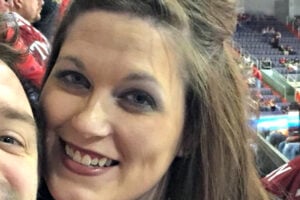I always thought of myself as person who wears many cape: a mom, a wife, and a friend. I was always on the go, shuffling my oldest child to high school and a job, taking both younger kids everywhere with me, while doing errands for myself, the house, the school, our brewery and at the end of the day, night school. I always lived in fast mode. Under those circumstances, you would think I could be a spokesperson for being able to take on anything.
At the end of 2012, I noticed I started having more health issues than usual, including occasional bronchitis, sinusitis, and asthma episodes. These issues continued into 2013. I went to the ER countless times, I was so sick, and repeatedly I was told, “It’s your asthma. Here is some prednisone, antibiotics, and pain pills for chest pain.” My D-dimer was negative, so they never checked further for blood clots, since my legs had no signs or symptoms of a DVT, and my chest pain seemed to be asthma-related. I noticed that every time doctors gave me the standard medications for bronchitis and asthma-related issues, they didn’t seem to work, and the pain in my chest, dizziness, and heart palpitations only grew worse. When I would show up at the ER, doctors began to treat me like I was in search of pain meds or addicted to them. The last ER visit – prior to the visit when my blood clot was discovered – doctors diagnosed me with pleurisy, and sent me home with the same medications. They did a D-dimer again, and it was negative. They even did a CT scan without contrast and said there was nothing unusual. I began to think I was crazy or something was wrong with me, and I became really scared.
In April 2013, I was in my kitchen and my daughter gave me something to cut open. Instead of using the scissors, I used a small, very sharp knife, which I later thought was dumb, but I am so glad I did, because it was from cutting myself with that knife that doctors eventually discovered a DVT and bilateral pulmonary embolisms – or blood clots in my leg and lungs. The knife cut me deep on the side of my finger. I told some friends on Facebook about it, and they urged me to go to the ER, just to be on the safe side, and to make sure it didn’t get infected. I was embarrassed, but I went to the ER. When I got there, they took my BP and it was 179/145, which was high. The medical staff was freaking out, and my thumb suddenly became the last priority. My pulse was racing at 137. They walked me back and did and EKG, D-dimer, and some more tests, while they cleaned and bandaged my finger. They instructed me to get a doctor right away about my high blood pressure, because it was serious.
The next day, I visited my doctor. My blood pressure was still high, and I was not feeling well in my chest. The doctor I saw decided to prescribe me another round of steroids and to recheck my blood pressure in two weeks. In that time, I went back with tingling sensations – which I describe as feeling like hyperventilating – on my left side from my neck, to my chest, arm, leg and foot. The doctor seemed puzzled. I went home and, a few days later, I could not get off of the couch. I had a raging headache and still had the same tingling symptoms, but worse, and I could barely move. I called the doctor and he suggested that I go the ER again.
The ER checked everything again and asked me if I would like to go home and see what tomorrow brings, or be observed overnight. I chose to be observed overnight, because I knew something was not right. They kept saying I was just having muscle spasms, which was causing the pain on my left side, and they would probably release me the next day. Then, a new doctor came to see me before they made the final decision to discharge me. We talked and he seemed very concerned and ordered a CT with contrast to check for blood clots, even though the D-dimer was still negative. Low and behold, nurses started rushing in, hooking me up to things, just as I was about to tell my mom I was going home. I put the phone down and asked what was going on. I was told, “You have clots in your lungs.” I thought, “What?! Me? Not me…I’m Super Mom. What is going on?” I was so confused. All kinds of emotions flooded through my brain. I cried, was terrified and confused.
The next day, the nurse asked if I would like to take a shower, and I said I would. When I was showering, I got this Charley horse sensation and pulling feeling in my left leg. It was very odd. I debated over whether or not to say anything and decided that I should. It is a good thing that I did. The nurse ordered a scan of my leg and there it was…a monster of a clot that was 18 inches in length. It was the culprit that caused the blood clots in my lungs.
The next day, I had a number of tests done, and about 20 vials of blood drawn for testing related to other potential problems like clotting disorders, and they all came back negative. I finally went to a hematologist who did further testing, which revealed that I have MTHFR C677T and the Prothrombin G20210A mutations (heterozygous and homozygous). What all this means for me now is that I will take blood thinners for the rest of my life. I also saw a genetic counselor to help me understand what was going on. I tested my oldest daughter and she too has the Prothrombin gene and was told to remove her contraceptive IUD for her safety. I am glad she knows about her family history. My two younger daughters will be tested when they are teens.
After coming home, I wanted to know more. I searched and searched the Internet, until I found two ladies that literally saved me. Linda Anglebrandt of the Pulmonary Embolism Awareness Project (PEAP) and Sara Wyen of Blood Clot Recovery Network, both administrators of online communities. They educated me, and helped me so much on this new journey. They helped me find my voice and encouraged me to help others through my story. I created Surviving a Silent Killer, a Facebook discussion community, to help other people like me. It has grown so much, and I have since added Surviving a Silent Killer..Let’s Talk Babies to help moms who have blood clots find other moms who are going through similar situations. I also created Surviving a Silent Killer…Weight Warriors, for those of us who have blood clots and gained weight, or for those who have a hard time losing weight since being diagnosed with a blood clot. I have some wonderful people to help me in every group, and I am blessed to have all of them. Together, we make a huge difference in other people’s lives every day.
I am super proud of everything I have accomplished, with special friends in my corner along the way. I even had a chance to fly to Chicago this year for the HealtheVoices16 conference, a health advocacy conference for online community administrators, blogs, and Twitter, where I learned how to take time to nurture myself and my communities, and how to keep my communities a viable resource for others. I even learned, among others things, how to make videos to reach more people. Together, we are all one voice advocating for blood clot awareness, and the care of others who have been affected by this illness.
Now, I am still Super Mom, but in a different and more special way. I see the world and my own life differently after coming so close to death. Thank you all who were by my side from the beginning…my husband, children, family, friends, and the people I have met that have given me my voice back to make a difference and spread awareness. Here I am, and here is where I want to be.



